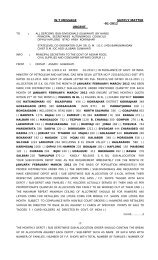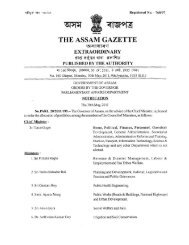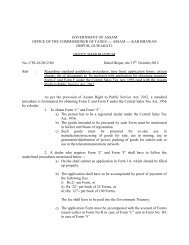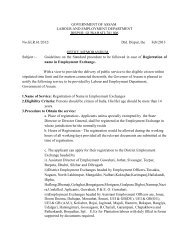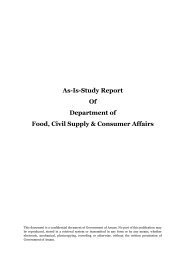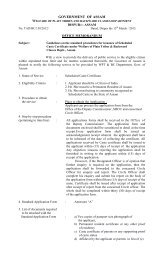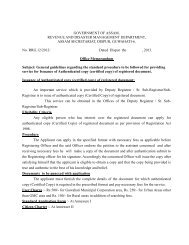public health engineering department - Assam Online Portal
public health engineering department - Assam Online Portal
public health engineering department - Assam Online Portal
Create successful ePaper yourself
Turn your PDF publications into a flip-book with our unique Google optimized e-Paper software.
As-Is and e-Readiness Study report on Public Health EngineeringDepartment, Govt. of <strong>Assam</strong>d) Sajal Gram PuraskarBackground:About 80% of rural drinking water sources are based on ground water. Many of the pipedwater supply schemes are based on single source. With rapid decline in ground water due toexcess withdrawal by competing users and inadequate knowledge on water conservation andharvesting, State Governments are reporting more and more habitations slipping back fromthe fully covered status. Therefore the strategy adopted by the Department is shift the focus of80% ground water based systems to 20% systems and the remaining by combination of roofwaterharvesting, ground water recharge and surface water harvesting as conjunctive use. Themove apparently shifts from single sources to sustainable multiple sources so that drinkingwater security is ensured.In various Workshops conducted the State Governments have been suggested to draw upvillage-wise, block-wise and district-wise drinking water security plans based on waterdemand, budgeting and availability. Further, catchment protection and environmentalsanitation are also key components of drinking water security plans so as to avoid/reducecontamination like nitrates from fertilizers and sewage pollution and bacteriologicalcontamination through leaching. Efforts are also being made for allocating sizable portion offunds for creating drinking water security through conjunctive use of water.The following issues may be addressed/ considered for ensuring sustainability of ruraldrinking water sources :• Water budgeting, demand, supply, conservation, costing, pricing are required.• Sub-surface storage of water specific to drinking water sources• Roof-water harvesting, either individual or community based, to provide adequacy ofdrinking water sources during rainy season and rest the ground water aquifers forrecharge as well as dilution of contaminants.• Stand alone systems for bacteriological contamination removal at the consumption pointafter ensuring sustainable availability of surface water• Drinking water sources could be seen as “Protected sources” like Reserved Forests.• Appropriate Media Campaigns for clean and safe water• New and renewable energy sources could be promoted• Participation of financial institutions including microfinance & NGOs in ensuringsustainable rural drinking water supply systems.• PRIs could initiate action against all polluters of protected drinking water sources on theRef.: AEDC/AOP/EOI/2009/10 Copyright : AEDC Ltd. 41




